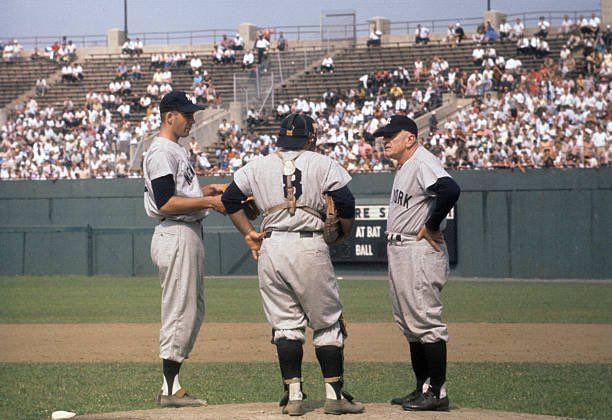Baseball History Comes Alive Now Ranked #2 by Feedspot Among All Internet Baseball History Websites and Blogs!
Guest Submissions from Our Readers Always Welcome!
Subscribe to Baseball History Comes Alive! for automatic updates (sign-up block found in right side-bar)
As a Free Bonus for subscribing, you’ll get instant access to my two Special Reports: Memorable World Series Moments and Gary’s Handy Dandy World Series Reference Guide!
“Managers and Relievers” Photo Gallery
Click on any image below to see photos in full size and to start Photo Gallery:
New Poll Question: How Do You Feel About the New 3-Batter Minimum Rule for Relief Pitchers?
My how the game has changed!
Many of us are old enough to remember the days when it was not unusual for starters to complete 25 to 30 games a year. Nor was it unusual for them to pitch 300 innings in a season. Great starters like Bob Gibson and Fergie Jenkins, among many others, come immediately to mind.
I also remember the days when teams had only one or two relievers. They often were washed up starters. In the 1950s, I can recall Don Elston as the Cubs’ designated reliever. He would be called in when the starter was having a bad day and couldn’t make it to the end of the game.
Of course, now in the modern game, it’s not unusual for teams to have seven or eight relievers: middle relievers, lefty bullpen specialists, set-up guys, eighth inning specialists, and the closer. With all these relievers – and until next season – with a roster of 25 players, spots previously occupied by pinch hitters and utility players are lost. As a consequence, it’s not unusual for managers to run out of players in extra innings.
Much of this may be coming to an end next season. As we know, major league baseball will put into effect the new 3-batter minimum rule for relievers entering the game.
How do you feel about this?
Personally, I’m glad. I normally don’t like to see rule changes that affect the basic fabric of the game, but I think something had to be done. I’ve been railing about the vastly over-used, often-ineffective lefty-righty late-inning switch for many years. The strategy fails at least as often as it’s successful. Plus, I’ll bet the endless parade of relievers in the seventh and eighth innings on average has to add at least a half-hour to the length of the average game. The major leagues have been searching for ways to shorten games. I think they’ve stumbled on to a good rule change.
In the featured photo, we see Casey Stengel on the mound to make a pitching change at Baltimore’s Memorial Stadium in the 1950s.
Mike Petriello, a writer for MLB News, had this to say about the reliever parade that has harmed the modern game:
Mid-inning pitching changes are a plague upon pace, and the game. They stop the action, and add none in return. The fewer of them we see, the better.
In 2018, there were 799 different pitchers to appear in a game, a new all-time record. This is a record that’s been broken each year since 2013, unsurprisingly. If we go back to 1998, the first year of the 30-team era, there were 557 pitchers, appearing in 4,864 games. In two decades, in a nearly identical number of games, the number of pitchers per game has shot up by 2.6, from 6.1 to 8.7.
I agree...
To get the pulse of our readers, I’ve started a poll on the question. Here’s your chance to voice your opinion on this new rule. Click on the link below and you will be taken to the poll. You can also leave a comment below or on our Baseball History Comes Alive! web page.
Shop MLB.com. The Official Online Shop of Major League Baseball.
Gary Livacari
Photo Credits: All from Google search
Check out my latest books both now available on Amazon in e-book and paperback: Reflections On the 1919 Black Sox: Time to Take Another Look. All profits go to the Illinois Veterans Foundation
We are a participant in the Amazon Services LLC Associates Program, an affiliate advertising program designed to provide a means for us to earn fees by linking to Amazon.com and affiliated sites. Click here to view Amazon’s privacy policy

















The ballpark is Memorial Stadium, Baltimore in the 1950’s.
Thanks!
I think it is a great Idea,may help to speed up the game
I would have to loved to grow up in the Memorial Stadium neighborhood in old Baltimore. I remember the beautiful homes beyond the centerfield wall and the tree lined streets. The ballpark was the prettiest in the late 1950’s thru the early ’60’s when spruce trees were abound beyond the outfield fence. The NFL Colts played there too. Oh, how I miss the days of Paul Richards’ “Baby Birds.”
Thanks James…great info!
Hi Gary:
I’ve hesitated to post in this space because, as you know, I stepped away from serious fandom some time ago, even though the length of the games has been complained about long before that. But, I thought I’d see what some other folks might have to say and no one really has commented, so here goes. I think a manager should have every tool at his disposal to try to win a ball game. If it’s bringing in a pitcher to pitch to one player, so be it. I enjoy the strategy and the counter strategy of opposing managers. To bunt or swing away; to try to steal or not; should the runner on third try to score on a shallow fly? It’s fascinating.
If you really want to heal a game, how about football. Any one-hour game that takes 3 – 4 hours to play is seriously flawed. Has anyone actually calculated the number of seconds to run a play against the number of minutes the players spend standing around between plays? That’s serious time.
Regards,
Joan